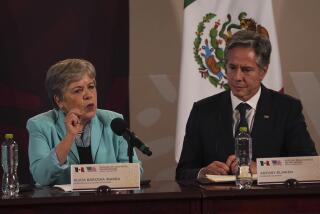U.S. Makes Another Stab at Debt Relief for Mexico : Banking: The Treasury’s new effort seeks to overcome a $500-million shortfall in funding arranged under the so-called Brady Plan.
WASHINGTON — The Treasury Department has decided to mount a last-ditch effort to rescue the flagging debt-relief agreement that Mexico signed with commercial banks last year under the Third World debt-reduction scheme proposed by U.S. Treasury Secretary Nicholas F. Brady.
Under the new rescue effort, the United States will sell Mexico special new bonds, apparently at discount prices, to help make up for a $500-million financing shortfall that has been holding up formal completion of the debt-relief package worked out by Mexico and the banks.
The shortfall arose after the individual banks that took part in the latest refinancing failed to provide the amount of cash that the Mexicans and the banks had anticipated when the deal was struck last fall. Efforts to secure additional loans so far have failed.
Because of the impasse, Mexico has faced increasing financial uncertainty over the past few months. U.S. officials initially predicted that the deal would be completed in early December but have revised that forecast several times as the effort faltered.
The fact that the Treasury had to mount such a rescue effort was viewed by some critics as another sign of serious shortcomings in the Brady Plan, which the secretary proposed last March.
Although the Brady Plan is almost a year old, only three countries--Mexico, Costa Rica and the Philippines--actually have benefited from it. And the Philippines’ latest debt-relief program was a separate effort worked out by the State Department.
Moreover, even the refinancing package involving Mexico--supposedly the model for the program, according to Treasury officials--has produced far less in actual financing than Mexico needs.
U.S. officials concede that even if the banks’ accord with Mexico had produced the full $7 billion in financing that it promised, it would still leave Mexico $1 billion to $1.5 billion short of what it needs to meet its import and debt-service bills.
The bonds, which the Treasury said Monday will have a value of about $33 billion when they mature 30 years from now, are known as zero-coupon bonds because they are bought at a deep discount and offer the holders no interest earnings until the bonds mature. Officials said Mexico would have to pay about $3.5 billion for the bonds.
Under Monday’s plan, Mexico would buy the zero-coupon bonds from the U.S. Treasury and then use them as collateral to buy back at a discount some debt that it currently owes to banks. Buying back the debt had been called for in the original agreement between Mexico and the banks.
The advantage to Mexico by the special issue of zero-coupon bonds is that Mexico will spend less for them up front than if it bought conventional bonds, which generally require higher interest payments.
A Treasury spokesman said Washington had agreed to set a price of 7.925%--which is one-eighth of a percentage point below the average market rate for 30-year securities for the three days that ended Jan. 5.
Experts outside the Treasury said it was impossible to tell whether the rate provided the Mexicans amounted to a slight subsidy by U.S. taxpayers, as some critics charged. The reason, they said, is that the Treasury offering to Mexico was unique, with no comparable market rate.
The shortfall in financing the new debt-relief package resulted because relatively few of the banks that agreed to participate in the new agreement proved willing to make additional loans to Mexico.
Instead, the lion’s share chose, in effect, to get out by exchanging large portions of their existing loan portfolios for new Mexican bonds whose interest payments were guaranteed by money from Mexico, Japan and organizations such as the International Monetary Fund.
Critics have argued repeatedly that one of the biggest flaws in the Brady Plan has been the choice that it gives commercial banks to abandon any further obligation to make new loans to Latin American governments if they so desire.
More to Read
Sign up for Essential California
The most important California stories and recommendations in your inbox every morning.
You may occasionally receive promotional content from the Los Angeles Times.










